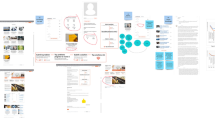Abstract
The “Wisdom of Crowds” hypothesis has been introduced into many fields, but not into education. Groups with diverse knowledge and skills make better decisions than homogenous groups or expert groups. Diversity adds different points of view, which improve the problem solving ability of the group. The increased use of social networks makes it possible to employ the wisdom of crowds for creating new educational approaches for teaching-learning purposes. This article demonstrates the use of the wisdom of crowds for preparing lesson plans and learning units. All lesson plans and learning units improved following the wisdom of crowds. Collaboration of crowds can be used in many ways, including writing exams, classroom interactions, turning topics into relevant material for pupils, suggesting alternative methods of evaluation, etc.
Similar content being viewed by others
References
Bechter, C., Jentzsch, S., & Frey, M. (2011). From wisdom of the crowd to crowdfunding. Journal of Communication & Compute, 8(11), 95.1.
Brabham, D. C. (2009). Crowdsourcing the public participation process for planning projects. Planning Theory, 8, 242–262.
Casari, M., Zhang, J.,& Jackson, C. (2012). When do groups perform better than individuals? A company takeover experiment. (Working Paper No. 504). Retrieved from file:///C:/Users/te01122/Downloads/iewwp504.pdf
Cooper, D. J., & Kagel, J. H. (2005). Are two heads better than one? Team versus individual play in signaling games. American Economic Review, 95(33), 477–509.
Dye, R. (2008). The promise of prediction markets: A roundtable. McKinsey Quarterly, 2, 83–93. Retrieved from http://engexecforum.com/external%20files/The%20Promise%20Prediction%20Markets.pdf
Fleenor, J. W. (2006). The wisdom of crowds: why the many are smarter than the few and how collective wisdom shapes business, economics, societies and nations. False Personnel Psychology, 59(4), 982–985.
Galton, F. (1907). Vox populi. Nature, 75, 450–451.
Giles, J. (2005). Internet encyclopedias go head to head. Nature, 438(15), 900–901.
Giles, J., Butler, D., Hogan, J., Hopkin, M., Peplow, M., & Simonite, T. (2005). Supplementary information to internet encyclopedia go head to head. On line at Nature, http://www2.stat.unibo.it/mazzocchi/macroeconomia/documenti/Nature%202006%20wikipedia.pdf
Harter, C. A., & Ku, H. Y. (2008). The effects of spatial contiguity within computer based instruction of group personalized two-step mathematics word problems. Computers in Human Behavior, 24(4), 1668–1685.
Hatzipanagos, S., & Warburton, S. (2009). Handbook of research on social software and developing community ontologies [Google Books Version]. Retrieved from http://www.google.co.il/books?hl = iw&lα = &id = gHbGQRm5Jq0C&oi = fnd&pg = PT55&dq = crowd + wisdom + learning&ots = sp6WcP8FQY&sig = _-REOqfWOXYy7onuLB5Y6G6hrmE&redir_esc = y#v = onepage&q = crowd%20wisdom%20learning&f = false
Mcintosh, M. E. (1997). Guide students to better comprehension of word problems. The Clearing House, 71(1), 26–32.
Ricks, T. E. (2009). A review of the wisdom of crowds. Complicity: An International Journal of Complexity and Education, 6(2), 152–155.
Sahin, O., & Soylu, Y. (2011). Mistakes and misconceptions of elementary school students about the concept of variable. Science Direct, 15, 3322–3327.
Sapolsky, R. (2011). Weirdness of the crowed. In J. Brockman (Ed.), How is the internet changing the way you think? The net’s impact on our minds and future. Great Britain: Atlantic Books.
Surowiecki, J. (2004). The wisdom of crowds: why the many are smarter than the few and how collective wisdom shapes business, economies, societies and nations. New York: Anchor.
Wilson, G. R. (2013). Goldcorp crowdsourcing: An industry best practice with potential for the intelligence community. JFQ, Joint Force Quarterly, 69, 2nd Quarter, 20–24.
Yampolskiy, R. V., Ashby, L., & Hassan, L. (2012). Wisdom of artificial crowds: a metaheuristic algorithm for optimization. False Journal of Intelligent Learning Systems and Applications, 4(2), 98–107.
Yaniv, H. (2011). Social network as a learners’ community – culture of learning for life. Bitaon, 46, 3–9.
Acknowledgments
The author thanks students: Keter Mor, Kotlash Michal and Navon Eyal whose assignments in my course were used as examples of wisdom of crowds for developing lesson plans and teaching units.
Author information
Authors and Affiliations
Corresponding author
Rights and permissions
About this article
Cite this article
Klieger, A. The Use of Social Networks to Employ the Wisdom of Crowds for Teaching. TechTrends 60, 124–128 (2016). https://doi.org/10.1007/s11528-016-0020-0
Published:
Issue Date:
DOI: https://doi.org/10.1007/s11528-016-0020-0




